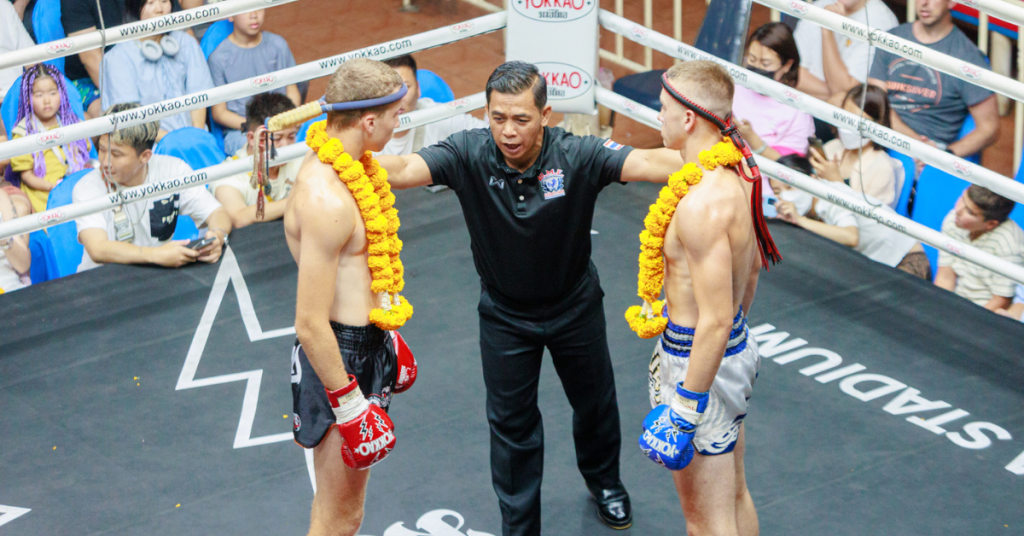Muay Thai, Thailand’s national sport known as the “Art of Eight Limbs,” follows a unique round structure that shapes every aspect of this ancient martial art. Whether you’re a beginner wondering “how many rounds in Muay Thai?” or an experienced practitioner seeking deeper strategic insights, this comprehensive guide covers everything about Muay Thai rounds, scoring systems, and fight dynamics.
Quick Facts: Muay Thai Rounds at a Glance
- Standard Fight Format: 5 rounds × 3 minutes each
- Rest Period: 2 minutes between rounds
- Total Fight Time: 23 minutes (including rest)
- Scoring System: 10-point must system
- Championship Fights: Same 5-round format
The Complete Structure of Muay Thai Rounds
Understanding the Muay Thai round structure is essential for fighters, trainers, and fans alike. This traditional format has remained consistent for decades, reflecting the sport’s deep cultural heritage.
Professional Muay Thai Round Duration
In professional Muay Thai competitions worldwide:
- Number of Rounds: 5 rounds (standard for all professional fights)
- Round Duration: 3 minutes per round
- Rest Periods: 2 minutes between each round
- Total Active Fighting Time: 15 minutes
- Total Event Duration: Approximately 23 minutes
This structure differs significantly from Western boxing’s variable round system (4-12 rounds) and MMA’s typical 3-round format.
The Sacred Five: Why 5 Rounds Matter
The five-round Muay Thai format isn’t arbitrary—it carries deep significance:
- Tactical Depth: Allows fighters to showcase complete skill sets
- Endurance Testing: Separates elite fighters from amateurs
- Strategic Evolution: Enables mid-fight adjustments and comebacks
- Cultural Symbolism: Represents the five Buddhist precepts
- Spectator Experience: Creates dramatic narrative arcs
Amateur vs Professional Round Differences
| Category | Professional | Amateur | Junior |
|---|---|---|---|
| Rounds | 5 × 3 min | 3 × 3 min | 3 × 2 min |
| Rest Period | 2 min | 1.5 min | 1 min |
| Total Time | 23 min | 13.5 min | 8 min |
Muay Thai Scoring System: How Rounds Are Judged
The Muay Thai scoring criteria emphasize technique, power, and traditional elements that distinguish it from other combat sports.
The 10-Point Must Scoring System Explained
Each round is scored independently using these criteria:
- Winner of Round: 10 points
- Loser of Round: 9 points (or 8 for knockdowns)
- Even Rounds: 10-10 (rare but possible)
- Dominant Rounds: 10-8 (significant damage/knockdowns)
Critical Scoring Factors (In Order of Importance)
- Effective Striking Impact
- Clean kicks to body/head (highest value)
- Knee strikes in clinch
- Elbow strikes causing visible damage
- Punches (lower value than kicks)
- Ring Generalship & Control
- Dictating fight pace
- Controlling center ring
- Forward pressure with technique
- Defensive Mastery
- Effective blocking and evasion
- Balance maintenance after strikes
- Counter-striking ability
- Traditional Muay Thai Technique
- Proper form and execution
- Balance and composure
- Respect for traditional elements
Round-by-Round Scoring Patterns
Rounds 1-2: Often considered “feeling out” rounds with lighter scoring weight
Round 3: Peak action round, heavily weighted by judges
Rounds 4-5: Critical for close fights, strong finishes often sway decisions
Strategic Considerations for Each Round
Successful fighters understand that Muay Thai round strategy evolves throughout the fight. Here’s how champions approach each phase:
Round 1: The Assessment Phase
- Feel out opponent’s rhythm and range
- Establish jab and teep (push kick)
- Conserve energy while gathering information
- Show respect through measured engagement
Round 2: Building Momentum
- Increase striking volume gradually
- Begin testing opponent’s defense
- Establish clinch dominance if applicable
- Set up combinations for later rounds
Round 3: The Pivotal Round
- Peak intensity and aggression
- Highest scoring weight in Thai judging
- Execute prepared combinations
- Seek to establish clear dominance
Round 4: Tactical Adjustments
- Adapt strategy based on score assessment
- Target opponent’s weaknesses discovered
- Manage energy for final round push
- Maintain or change momentum as needed
Round 5: The Championship Round
- Maximum effort if fight is close
- Strong finishes influence judge memory
- Display heart and warrior spirit
- Seek decisive victory or secure decision
Differences from Other Combat Sports
Understanding how Muay Thai rounds compare to boxing and MMA highlights the unique demands of each sport.
Muay Thai vs Boxing Rounds
While both use similar round lengths, key differences include:
Boxing vs Muay Thai Round Comparison:
- Boxing: 4-12 rounds, championship fights 12 rounds
- Muay Thai: Always 5 rounds professionally
- Pacing: Boxing allows more energy conservation
- Scoring Focus: Boxing emphasizes punch volume; Muay Thai values kick effectiveness
Muay Thai vs MMA Rounds
The differences between Muay Thai and MMA rounds include:
- MMA Standard: 3 rounds × 5 minutes (15 minutes total)
- MMA Championship: 5 rounds × 5 minutes (25 minutes total)
- Ground Game: MMA rounds include grappling time
- Striking Pace: Muay Thai maintains higher striking rate
Cultural Elements in Muay Thai Rounds
The spiritual and cultural aspects make Muay Thai rounds unique in combat sports.
Pre-Fight Rituals: Wai Kru and Ram Muay
Before Round 1 begins, fighters perform the sacred Wai Kru ritual:
- Duration: 3-5 minutes before fight
- Purpose: Honor teachers and seek protection
- Impact: Mental preparation and focus
- Judging: Not scored but shows respect
Sarama Music: The Rhythm of Combat
Traditional Thai music (Sarama) accompanies all rounds:
- Tempo Changes: Increases with fight intensity
- Round Indicators: Musicians adjust to action
- Fighter Motivation: Rhythm influences striking pace
- Cultural Authenticity: Unique to Muay Thai globally
Training for 5-Round Muay Thai Fights
Preparing for the Muay Thai 5-round format requires specific conditioning approaches covered in our beginner’s guide to Muay Thai classes.
Essential Conditioning Components
- Aerobic Base Building
- 5-10km runs at moderate pace
- 3-4 times weekly minimum
- Builds foundational endurance
- Anaerobic Power Development
- 5×3-minute rounds heavy bag work
- 2-minute active recovery between
- Mimics fight conditions exactly
- Clinch Endurance Training
- 5-minute continuous clinch rounds
- Emphasize position changes
- Build neck and core strength
- Mental Toughness Preparation
- Visualization of all 5 rounds
- Fatigue management strategies
- Pressure situation drilling
Frequently Asked Questions About Muay Thai Rounds
How many rounds are in a professional Muay Thai fight?
Professional Muay Thai fights consist of 5 rounds, each lasting 3 minutes with 2-minute rest periods between rounds. This is the standard format used in stadiums throughout Thailand and international competitions.
Why does Muay Thai have 5 rounds instead of 3 like MMA?
The 5-round format in Muay Thai allows for greater tactical depth, endurance testing, and aligns with Thai cultural traditions. It provides fighters more opportunity to showcase technical skills and make strategic adjustments during the fight.
How long is a complete Muay Thai fight including breaks?
A full professional Muay Thai fight lasts approximately 23 minutes total: 15 minutes of fighting (5 rounds × 3 minutes) plus 8 minutes of rest periods (4 breaks × 2 minutes).
Do all Muay Thai fights go the full 5 rounds?
No, fights can end early through knockout (KO), technical knockout (TKO), or referee stoppage. However, if no stoppage occurs, the fight goes to the judges’ scorecards after 5 complete rounds.
How is each round scored in Muay Thai?
Muay Thai uses the 10-point must system where the round winner receives 10 points and the loser typically gets 9 points. Judges prioritize effective kicks, knee strikes, ring control, and traditional Muay Thai technique.
Which round is most important in Muay Thai scoring?
In traditional Thai scoring, rounds 3, 4, and 5 carry more weight, with round 3 often considered pivotal. Judges tend to remember strong finishes, making the final 30 seconds of each round particularly important.
Can there be draws in Muay Thai?
Yes, draws are possible but rare in Muay Thai. They occur when judges score the fight evenly across all rounds or when the total points are equal after 5 rounds.
How do Muay Thai round rules differ in different countries?
While Thailand maintains the traditional 5×3 minute format, some international promotions may use modified rules. However, authentic Muay Thai organizations worldwide follow the standard 5-round professional format.
Training at HKT Boxing Stadium Phuket
Ready to experience authentic Muay Thai training? At HKT Boxing Stadium in Phuket, our experienced trainers prepare fighters for the demands of 5-round competition through:
- Professional coaching from stadium champions
- Structured programs for all skill levels
- Authentic Thai training methods
- Conditioning specific to 5-round fights
- Regular sparring and technique sessions
Whether you’re preparing for competition or training for fitness, understanding Muay Thai rounds enhances your appreciation and performance in the Art of Eight Limbs.
Mastering the 5-Round Journey
The Muay Thai round structure represents more than just time segments—it embodies the sport’s strategic depth, cultural richness, and physical demands. From the opening bell to the final second of round 5, each moment offers opportunities for victory through technique, heart, and tactical intelligence.
Understanding how rounds work in Muay Thai, from scoring nuances to strategic approaches, elevates both practitioners and spectators’ appreciation of this ancient art. Whether you’re stepping into the ring or watching from ringside, the five-round format continues to showcase why Muay Thai remains one of the world’s most respected and challenging combat sports.
For more insights into Muay Thai training and competition, explore our comprehensive guides on Muay Thai techniques, training in Phuket, and understanding Thai boxing culture.












